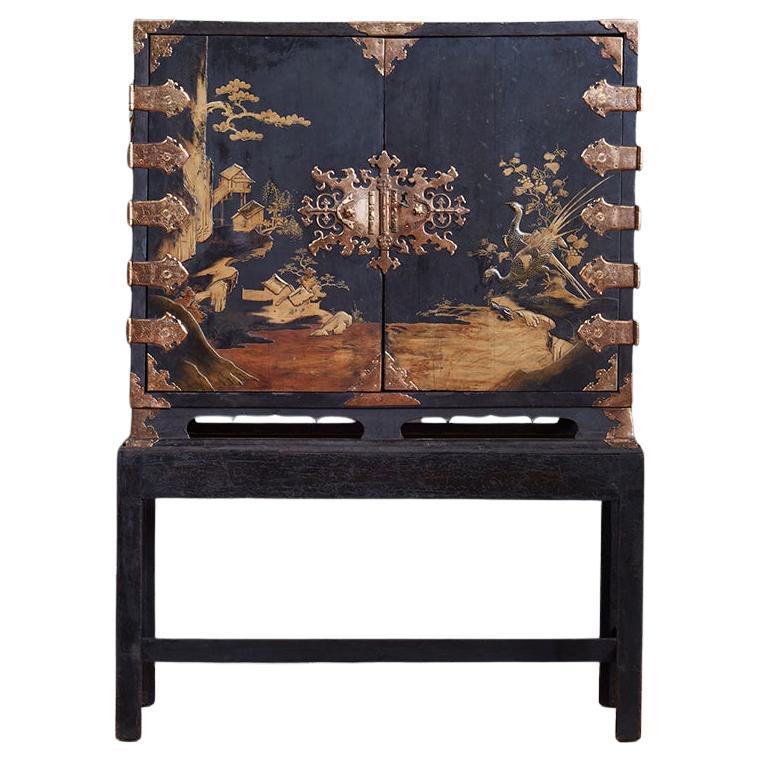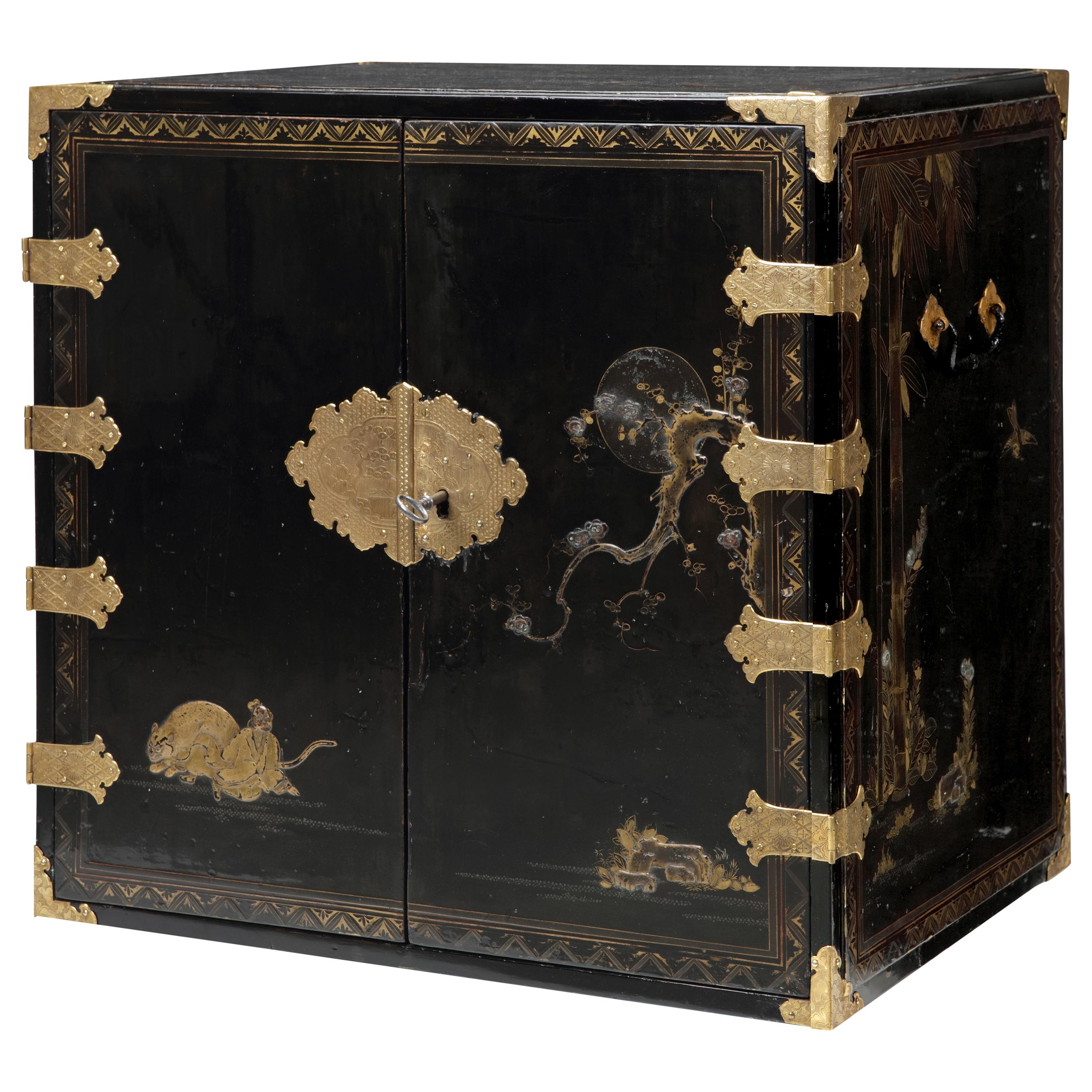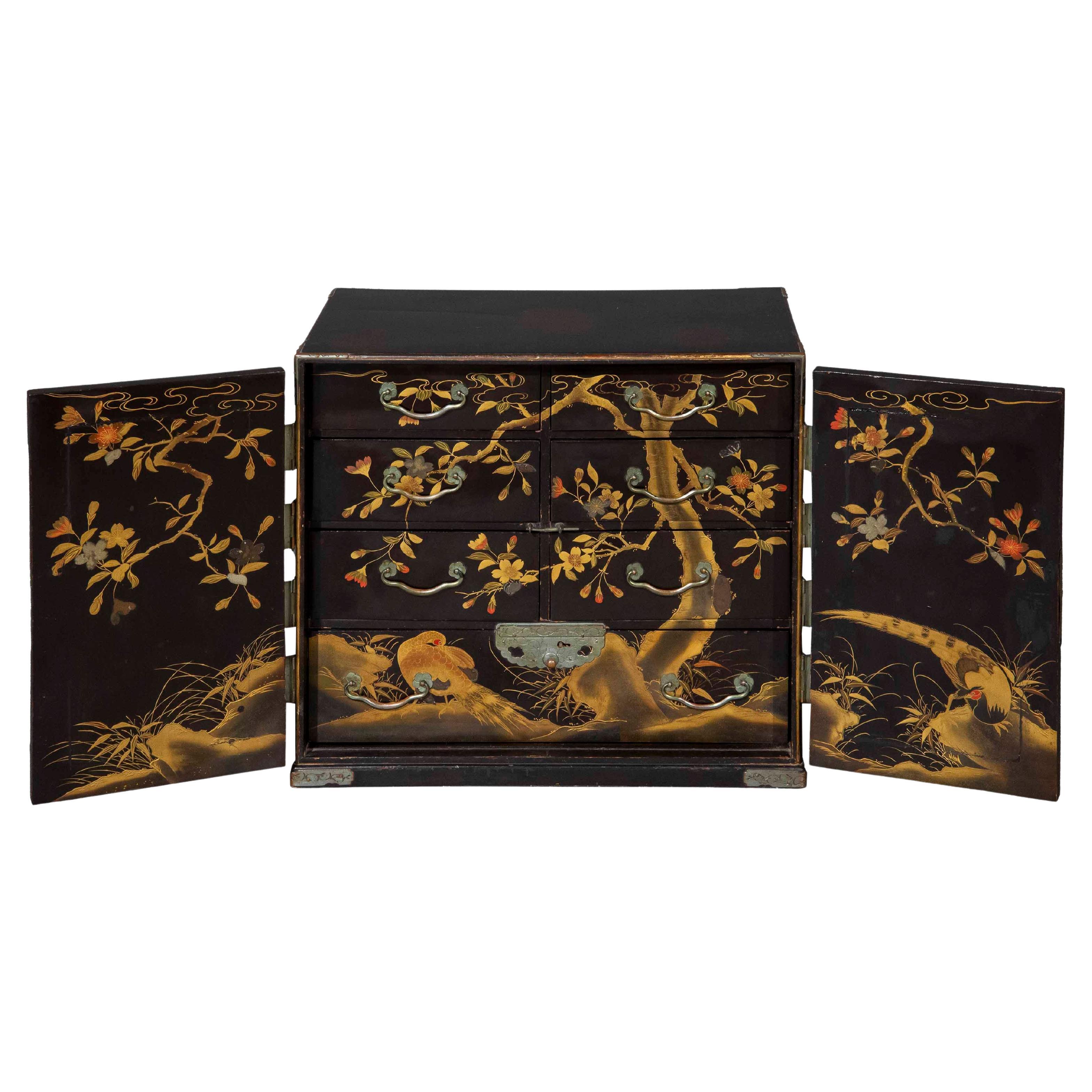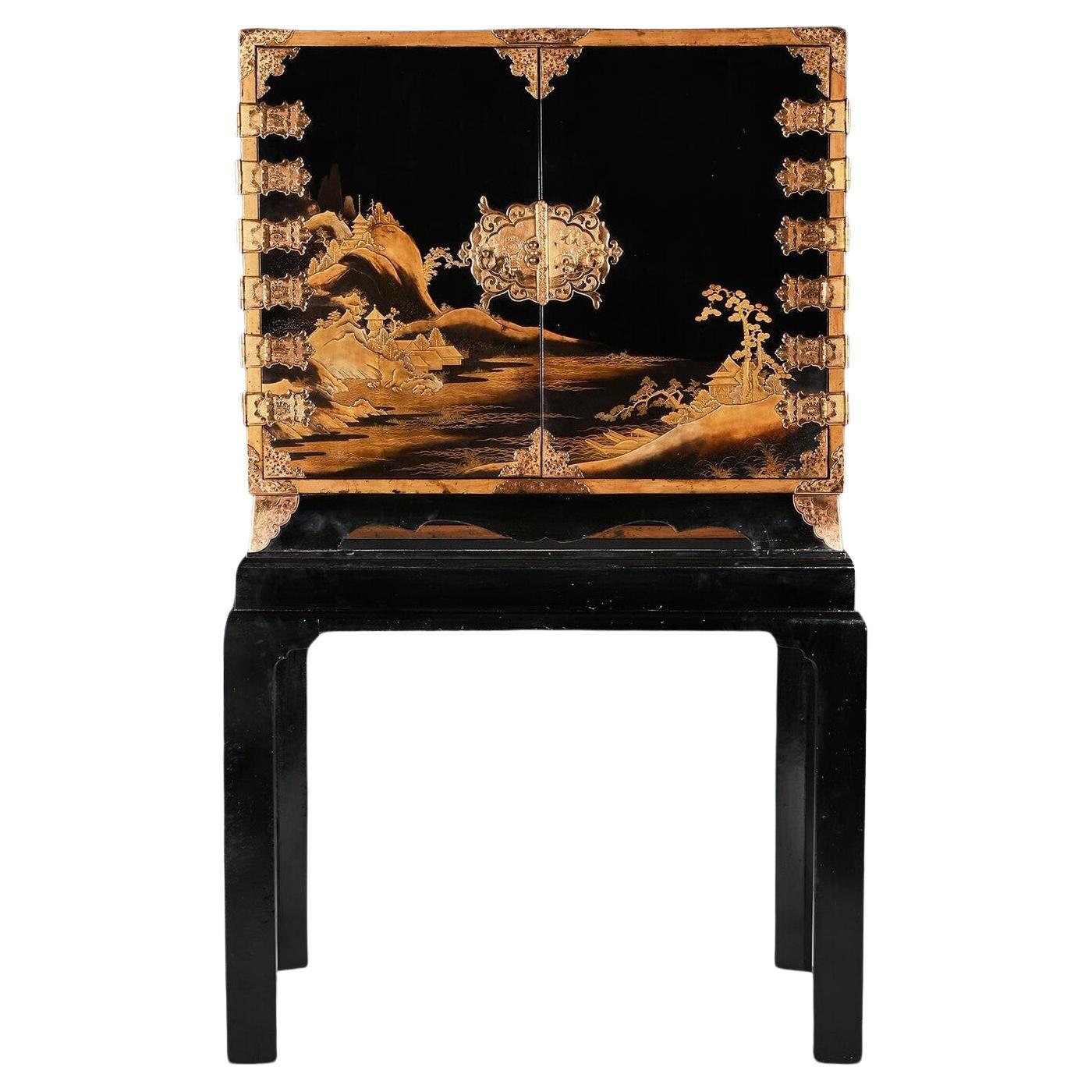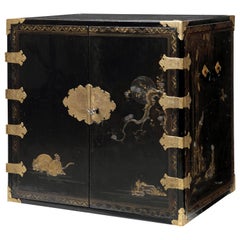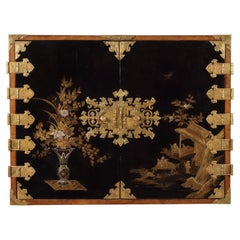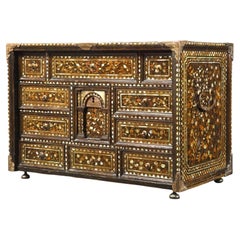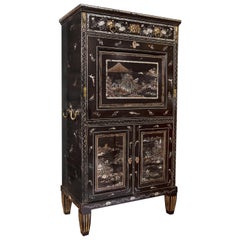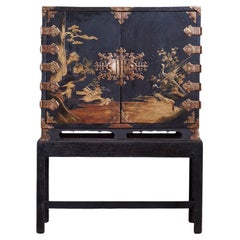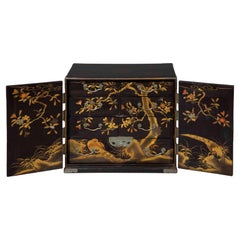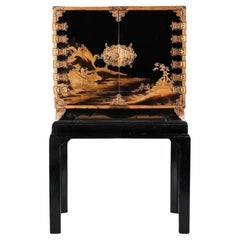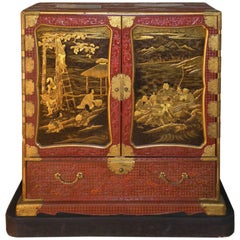Items Similar to 17th Century Japanese Export Lacquer Cabinet with Depiction the Dutch Tradepost
Video Loading
Want more images or videos?
Request additional images or videos from the seller
1 of 8
17th Century Japanese Export Lacquer Cabinet with Depiction the Dutch Tradepost
$1,498,973.64
£1,115,084.99
€1,250,000
CA$2,052,607.57
A$2,282,220.35
CHF 1,191,649.57
MX$27,780,178.74
NOK 15,204,929.10
SEK 14,246,291.98
DKK 9,515,559.64
Shipping
Retrieving quote...The 1stDibs Promise:
Authenticity Guarantee,
Money-Back Guarantee,
24-Hour Cancellation
About the Item
A highly important Japanese export lacquer cabinet with depiction of the Dutch East India Company tradepost Deshima and the annual Dutch delegation on its way to the Shogun in Edo
Edo period, circa 1660-1680
H. 88 x W. 100.5 x D. 54 cm
This cabinet includes a later European japanned stand, but also a modern powder-coated steel frame.
The latter can be designed and added to your specific needs.
The sides and front of the rectangular two-door cabinet are embellished in gold and silver hiramaki-e and takamaki-e on a black roiro lacquer ground with a continuous design. The two doors depict a long procession of numerous figures travelling on foot and horseback along buildings and a pagoda into a mountainous landscape. This is the annual court journey, Hofreis, of the Dutch from Nagasaki to the Shogun’s court in Edo. Three horseback riders are dressed as Dutch merchants and a fourth figure, probably het Opperhoofd, is seen inside a palanquin, norimon. Just about to cross the bridge, two men are carrying a cabinet like the present one.
Many Japanese figures on either side of the procession are engaged in various activities; some play musical instruments on board of small boats, others are fishing; figures inside buildings are depicted playing go, and farmers are tending to their rice paddocks. The upper part of the right door shows a large mansion, probably the local daimyo’s castle, with men kneeling before a man in the central courtyard.
The court journey fits in with the foreign policy of the shogunate which accorded a role to the VOC alongside China, Korea, and the Ryukyu Islands who also had to pay tribute. However, the VOC employees were traders, having low status in Japan’s social hierarchy, and they were received with less deference than were the state embassies from Korea and the Ryukyu Islands. Nevertheless, the contacts with the Dutch were a welcome source of information to the Shogun about Europe and European science and technology.
The left side of the cabinet depicts, in mirror image, a rare view of the artificial fan-shaped Deshima Island, the trading post for the Dutch in Japan. The island, where the Dutch flag flies, is surrounded by small Japanese boats and an anchored three-masted fluyt (cargo ship), flying Dutch flags, with on the stern the VOC monogram. On the bottom right a busy street of Nagasaki is shown, bordered by shops and leading up to the stone bridge. On the island the trees are beautifully painted, two cows can be seen, and the flagpole, all in very fine detail. Dutchmen and enslaved Malay are visible outside the buildings and two Japanese figures, probably guards, sit in a small hut in the centre.
A maximum of fifteen to twenty Dutchmen lived on the island at any time and soldiers or women were not allowed. Restrictions on Deshima were tight, and the merchants were only allowed to leave the island by special permission. The Opperhoofd had to be replaced every year, and each new Opperhoofd had to make a court journey to pay tribute, present gifts, and to obtain permission to Margaret Barclay eep on trading. In the distance, many birds fly above the hills and a four-story pagoda can be seen. The right side of the cabinet is painted with other horse riders and their retinue journeying through mountains.
The pair of doors to the front open to reveal ten rectangular drawers. The drawers are decorated with scenes of birds in flight and landscapes with trees and plants. The reverse of the left door with two thatched buildings, one with a ladder, underneath a camelia tree with large blooms; the right door with a three-story pagoda nestled among trees and both doors with a flying phoenix, ho-oo bird. The cabinet, with elaborately engraved gilt copper mounts, hinges, lock plates and brass handles, is raised on an 18th-century English japanned wood stand.
A pair of large cabinets (H. 109 x W. 117 x D. 73 cm) with eighteen drawers behind the front doors, instead of the ten in the present cabinet, is in the Dutch Royal Collection presently in palace Huis ten Bosch in The Hague. Among the largest known, these two beautiful cabinets can be dated around 1660-1680. The subject of the decorations on these cabinets is the same as on the present cabinet; the procession of the Dutch, with the Opperhoofd in a sedan chair, norimon, carried by four bearers, the scribe, or head secretary, and the trading post physician, accompanied by a large entourage of Japanese officials and servants, leaving Deshima Island on the court journey to the Shogun in Edo. The Royal pair of cabinets depicts the procession of the Dutch in mirror image; one shows the departure of the procession from Deshima Island going from left to right, and the other the same procession going from right to left.
These two cabinets were first inventoried in 1684 when they belonged to Princess Albertina Agnes (1634-1696), daughter of Stadtholder Frederik Hendrik (1584-1647) and Amalia van Solms (1602-1675). They were part of the furnishings of Albertina’s castle Oranienstein in Dietz, Germany. This pair, which must have been very expensive, was probably a gift by the VOC to her mother Amalia - although no sources prove this. However, it would be unlikely for the VOC to present the sixth daughter of Amalia, who lived in Germany with such an exuberant gift. It is known that the VOC gifted Amalia about 20 years earlier a bed of state fence in fine lacquer, of which in 2021 we discovered one intact baluster. Albertina Agnes in 1652 married her second cousin Willem Frederik van Nassau-Dietz, Stadtholder of Friesland, Groningen and Drenthe, and the ancestor of the present Dutch Royal family.
A fourth cabinet depicting Deshima and the procession of the Dutch on their court journey to Edo is in the Muse´e des Beaux-Arts, Dijon (inv. 3550-6) and was exhibited in the exhibition ‘Asia in Amsterdam, the culture of luxury in the Golden Age’ in the Rijksmuseum, 17 October
2015 – 17 January 2016, and in the Peabody Essex Museum, 27 February – 5 June 2016. This cabinet is not covered in black lacquer but in transparent lacquer with gold and silver hiramaki-e and takamaki-e lacquer, gold foil and copper mounts, and is dated between 1665 and 1685. The landscape on the doors is dominated by Mount Fuji in silver maki-e, which in its original non-oxidized state would clearly have shown the snow-clad mountain top. On the right side of the cabinet is the procession of the Dutch on their annual court journey to pay their respect to the Shogun in Edo. The left side of the cabinet shows the Dutch trading post on Deshima in the port of Nagasaki.
The present cabinet and the one in the Muse´e des Beaux- Arts in Dijon must have been ordered by or for a high-ranking VOC official at about the same time the two cabinets in the Royal Collection were commissioned, most likely by the Amsterdam VOC Chamber.
The present cabinet is slightly smaller than the Royal pair of cabinets and the Muse´e des Beaux-Arts one but arguably is finer in detail.
Provenance:
English private collection formerly at Cliff Avenue, Cromer, Norfolk, since the 1950s and thence by descent.
By repute purchased by the family from Margaret Jane Barclay (1861- 1958) of Herne Close, Cromer, together with the entire contents of her house. An album with watercolours by Margaret Barclay was found in the cabinet.
Margaret’s ancestor James Barclay (1708-1766), established Barclay’s banking dynasty. The cabinet was likely purchased by Margaret’s father, Joseph Gurney Barclay (1816-1898), who built Herne Close as a holiday house and furnished it. Joseph was one of the wealthiest members of the Barclay family, leaving many properties and a fortune to his children after his death.
- Dimensions:Height: 34.65 in (88 cm)Width: 39.57 in (100.5 cm)Depth: 21.26 in (54 cm)
- Style:Edo (Of the Period)
- Materials and Techniques:
- Place of Origin:
- Period:
- Date of Manufacture:circa 1660-1680
- Condition:Wear consistent with age and use. Minor losses. The cabinet has been cleaned, and a new upper layer of urushi lacquer has been applied to deepen the black.
- Seller Location:Amsterdam, NL
- Reference Number:1stDibs: LU5458233869942
About the Seller
5.0
Recognized Seller
These prestigious sellers are industry leaders and represent the highest echelon for item quality and design.
Established in 1985
1stDibs seller since 2020
23 sales on 1stDibs
Typical response time: 2 hours
- ShippingRetrieving quote...Shipping from: Amsterdam, Netherlands
- Return Policy
Authenticity Guarantee
In the unlikely event there’s an issue with an item’s authenticity, contact us within 1 year for a full refund. DetailsMoney-Back Guarantee
If your item is not as described, is damaged in transit, or does not arrive, contact us within 7 days for a full refund. Details24-Hour Cancellation
You have a 24-hour grace period in which to reconsider your purchase, with no questions asked.Vetted Professional Sellers
Our world-class sellers must adhere to strict standards for service and quality, maintaining the integrity of our listings.Price-Match Guarantee
If you find that a seller listed the same item for a lower price elsewhere, we’ll match it.Trusted Global Delivery
Our best-in-class carrier network provides specialized shipping options worldwide, including custom delivery.More From This Seller
View AllRare Charming 17th Century Japanese Lacquer Cabinet with Gilt-Bronze Mounts
Located in Amsterdam, NL
A fine Japanese pictoral style lacquer cabinet with gilt-metal mounts
Kyoto, Edo period, 1670-1690
Decorated in Japanese relief lacquer work, black lacquer ground decorated...
Category
Antique Late 17th Century Japanese Furniture
Materials
Bronze
$44,969 Sale Price
25% Off
Free Shipping
Extremely Fine and Rare 17th-Century Japanese Export Lacquer and Inlaid Cabinet
Located in Amsterdam, NL
An extremely fine and important Japanese lacquer cabinet with gilt-copper mounts for the European market
Edo period, late 17th century
The pictorial style decorated rectangular...
Category
Antique Late 17th Century Japanese Lacquer
Materials
Brass
Price Upon Request
Free Shipping
Portuguese-colonial Japanese Namban lacquer Vargueno Cabinet, circa 1600
Located in Amsterdam, NL
A Portuguese-colonial Japanese Namban lacquer vargueno cabinet
Momoyama period, circa 1600
H. 43 x W. 64.5 x D. 36 cm
Wood, black lacquered and deco...
Category
Antique Early 1600s Japanese Antiquities
Materials
Gold, Brass
Japanese Export Lacquer Mother-of-Pearl Secretaire for the American Market
Located in Amsterdam, NL
A rare Japanese export lacquered secretaire for the American market
Circa 1800-1830, Colonial
Overall densely decorated with flower sprays and landscapes, minutely inlaid with ...
Category
Antique 1810s Japanese Edo Furniture
Materials
Mother-of-Pearl, Wood
Large Royal Early 17th Century Japanese Lacquer Chest with Gilt-Bronze Mounts
Located in Amsterdam, NL
A large Japanese transitional lacquer chest with gilt-metal mounts
Edo period, early 17th century
The rectangular chest with flat hinged lid decorated in gold, silver, and red ...
Category
Antique Early 17th Century Japanese Blanket Chests
Materials
Bronze
17th-Century Japanese Namban Lacquer Coffer on French Stand, Possibly by Boulle
By André-Charles Boulle
Located in Amsterdam, NL
An impressive and large Japanese 'Namban' transition-style lacquer coffer with fine gilt copper mounts on a French Re´gence base, possibly by André-Charles Boulle (1642-1732)
Kyoto, 1640-1650, the base 18th century
?The coffer with shaped cartouches on a nashiji ground on the lid, front and sides, with fine decorations in various techniques: takimaki-e (high relief), tsuke-gaki (drawing with narrow lacquer lines and over sprinkling with gold and silver), usuniku-takamei-e (demi relief), kimekomi (pushed inside) and accents of kirigane (small geometrical metal mosaics). Inside the cartouche on the lid a landscape with volcanos...
Category
Antique 17th Century Japanese Lacquer
Materials
Brass, Ormolu
You May Also Like
A Mid Eighteenth Century Japanese Lacquer Cabinet
Located in London, GB
Using Japanese “Urushi” lacquer in a beautifully untouched and sleepy condition, on later stand, This Japanese lacquer cabinet on the stand has...
Category
Antique Mid-18th Century Japanese Edo Cabinets
Materials
Wood, Lacquer
19th Century Japanese Lacquer Table Cabinet
Located in Richmond, London
A fine and rare Japanese black lacquer table or jewellery cabinet, exquisitely decorated in intricate detail, dating to the late Meiji per...
Category
Antique Late 19th Century Japanese Meiji Lacquer
Materials
Metal
An Important Late 17th Century Japanese Lacquered Cabinet Edo Period on Stand
Located in Benington, Herts
An extremely fine, elegant and rare late 17th Century Japanese lacquer cabinet, from the Eco period, on later lacquered black stand.
Japanese circa 1690
Provenance
A private Scottish collection
This outstanding cabinet is a fascinating fusion of east and west. The cabinet itself would have been made in Japan, c.1690, and is decorated to the outside with hiramaki-e lacquer. This technique involves the use of sprinkled gold powder which adheres to the lacquer surface. On the best pieces, as with this example, many layers are added in order to create areas of high relief and give depth to the surface decoration. The taste of the Japanese workshops in this period was often for quite restrained pieces with plenty of the black background visible, unlike some of the busier Chinese lacquer or European japanned examples produced around the same time. The Japanese makers seemed content to rely on the outstanding quality of the lacquer itself, regarded by most experts as the finest lacquer ever produced, and did not see the need to cover every surface believing that less was more in this respect. The lacquer here is used to produce a mountainous scene with buildings on the bank of a river, the other side of the river with more buildings and a contrasting flatter and forested landscape. The fine perspective achieved is the result of the clever use of raised and flatter areas in the lacquer itself in combination with the drawing of the design itself.
Another remarkable aspect of this piece is the fine metalware throughout, but particularly the lockplate / hasp, hinges and foot mounts to the front. This is all beautifully cast and engraved contrasting against the black background. Interestingly another cabinet on stand with near identical metalwork was advertised in the Burlington Magazine, November 1913, with the dealer W. Williamson and Sons of Guildford. The lacquer on that piece is similarly refined and it seems likely that both pieces came from the same workshop.
The European influence in our piece can be seen in both the later ebonised stand and in the japanned decoration which has been applied to the inside of the doors and is also very fine indeed. This consists of two panels with birds of prey perched on branches in colours set against a golden background. The cabinet has a recent Scottish provenance and so it is likely that the ebonised stand was made in Britain though such pieces were made throughout Europe as a way of quite literally elevating these imported pieces of eastern lacquer as in Japan these would have been used on the floor. Inside the cabinet there is a combination of more Japanese lacquer and lock plates and European drawer handles. Most of the lacquer drawer fronts incorporate mountainous scenes and birds in combination, with a few purely one or the other of the two subjects. Again the lacquer is in excellent condition and is of exceptional quality with multiple layers of relief used in one single scene in many cases.
As mentioned above, Japanese lacquer is the most technically brilliant of the eastern lacquers and, as such, was highly prized by collectors and connoisseurs throughout Europe when this piece was made. The acquisition of such pieces would only have been possible for a small group of incredibly wealthy individuals, largely royal or high ranking courtiers or merchants connected with the East India trade...
Category
Antique 1690s Japanese Edo Cabinets
Materials
Lacquer
Japanese Lacquer and Cinnabar "Samurai" Cabinet, Inaba Family, Edo Period
Located in Troy, NY
Exceptionally large and rare lacquer cabinet. According to the heraldry, visible on the headgear in one of the panels, it was made for the Inaba family, a high ranking Daimyo family,...
Category
Antique Late 19th Century Japanese Edo Lacquer
Materials
Wood
Japanese Lacquer Meiji Period Cabinet on Stand, circa 1890
Located in Brighton, Sussex
A exquisite, fine quality Meiji period (1868-1912) Japanese black lacquer cabinet on stand with wonderful scrolling gilded decoration. H...
Category
Antique Late 19th Century Japanese Japonisme Lacquer
Materials
Lacquer
Early 18th century Japanese Lacquer Cabinet on Stand
Located in Rīga, LV
Rectangular cabinet has nine drawers inside. Hinges, corner mounts and lock plates in gilt brass. Decorated with river landscapes, insects, birds and animals in pairs. The stand is i...
Category
Antique Early 18th Century English George III Cabinets
Materials
Wood, Lacquer
More Ways To Browse
The Lacquer Company
Black Gold Lacquer
Holland And Company
17th Century Dutch Furniture
Century Furniture Company Asian Furniture
Large Lacquer Cabinet
Lacquer Post Modern Chairs
Black Lacquer Brass Cabinet
17th Century Ship
17th Century Copper
Chinese Lacquer Cabinet
Japanese Wood Plate
Chinese Export Lacquer
Japanese Boat
Antique Chinese Lacquer Cabinet
Antique Chinese Lacquer Cabinets
Lacquer Mirror Antique
17th Century Cross
